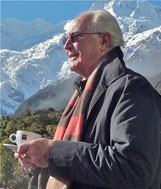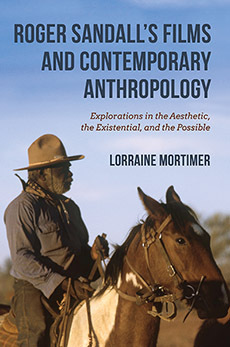The humor in Robert Flaherty’s famous 1922 film Nanook of the North is pretty simple stuff — conjuring an extraordinary number of well-stowed children out of one tiny kayak; sliding clownishly about on the ice harpooning a seal. But however simple, Nanook usefully taught millions of us that we all laugh at much the same things. Why is it that until Bruce Parry and the recent BBC series Tribe, humour has been so rare among its countless successors?
 |
| Bruce Parry and Friend, Bhutan |
Of course in 1922 the film-maker didn’t have an anthropologist along with him in Hudson Bay, and that may have influenced things. To begin with, anthropologists are mostly serious chaps who have been to college, whereas tribal people are tough chaps who have not — and to speak plainly, the serious chaps and the tough chaps have little in common. Robert Flaherty himself was a robust and hearty prospector who had spent some years looking for iron ore. One of the tough. He was fully accepted by the Inuit, whom he admired for their indestructible good humour, while the Inuit in turn took to Flaherty as someone able to handle Arctic hardships smilingly day after day.
Most anthropologists are rather different. As romantics (and anthropology is the home of academic romanticism) they incline to a tragically moralistic view of life the opposite of their hosts. Hunters learn to expect misfortune and bad days, but whatever happens you have to get on with it. A moping hunter who sat around complaining that life wasn’t fair would be dead in a week.
Again, where Flaherty was fully accepted as an equal long before shooting his film, your average anthropologist yearns for a social acceptance that is always uncertain, and even after years of fieldwork may never arrive. A creature of the seminar room whose mentality has been formed by the ambiguous pleasures of university life, his own tribe is incurably academic. Abroad, he tiptoes through the forests of alien cultures fearful of solecism and hardly daring to laugh at all.
There are other problems too. The academic outlook in Brian Moser’s distinguished Disappearing World series in the 1970s was both pedagogic and high-minded, and high-mindedness comes at a price. Tribal humour was never intended for classroom use. Granada’s editorial guidelines ensured that in one place after another, all over the world, an entire comic universe of ribaldry and sexual taunting and obscene hilarity was hardly glimpsed.
A ceremony I myself filmed in Central Australia at around the same time featured a much-loved priapic hero, Wadaingula. During his dance he carried a phallic emblem six feet long, with other dimensions to match, and after white feathers had been stuck onto it with human blood it was menacingly waved about. Bush flies in Central Australia are not just a nuisance, they’re a curse, and imaginary flies that landed on the sacred emblem were indignantly brushed off by the dancer, while the audience howled with delight. But in Canberra the whole event was considered unfortunate: the film was solemnly locked away and has not been seen since.
Multiculturalism reinforced this bowdlerising. It ensured that a proper respect was shown during editing and that disagreeable customs were either unmentioned, euphemised, or cut. Cannibalism was certainly unmentionable. Whipping rituals designed to harden women and children against pain were likely to be suppressed. And in one Disappearing World production clitorodectomy among the Masai was actually compared to “a white wedding”.
In such an atmosphere humour suffocates and laughter dies. And that’s why the recent BBC series Tribe is so refreshing. Everywhere indigenes are seen joking, teasing, and generally enjoying themselves. The rationale for the show was that Bruce Parry, a self-described “explorer” and “expedition leader”, should step out of his aircraft and walk straight into the homes of Siberian reindeer herders or Papuan forest hunters, eating raw liver, drinking blood from the communal calabash, and living “as one of the tribe”. But how on earth can you live as one of a tribe whose language you don’t speak, whose most ordinary routines are unfamiliar, and whose food — from rats’ intestines to sago grubs — you find disgusting? Yet in a roundabout and unintended way it works, triumphantly restoring laughter to men and women we have rarely seen laughing before.
This is not because our explorer cuts an impressive figure — quite the reverse. It works because he’s an unimpressive figure, the butt of children’s jokes, who should at times be wearing a jester’s cap and bells. In Outer Mongolia he’s keen to ride, but after losing his saddle bag he manages to lose his horse. In Ethiopia’s Omo Valley young Suri men joust ferociously, trying to disable each other with long pointed hardwood sticks. Parry plans to show his mettle. But the Suri King, used to hot-heads, foresees disaster and intervenes — though not before the tyro’s clumsy efforts bring gales of laughter from a delighted audience. Everywhere Parry is eager to join the hunt. Hunting is manly action and he wants in. But his presence hinders. He disturbs the quarry. He can’t keep up. So he’s often treated as a backward child and told to stay home with the women.
But this is all for the best. Among these women we meet some splendid characters and discover what the word “unflinching” truly means. In Ethiopia a smiling Suri girl is cicatrised on her breasts, and banters with Parry as her blood streams down (he himself, to much amusement, gaspingly suffers a single cut). Among the nearby Dassanech an elder named Abanesh forthrightly defends female genital mutilation, and shows why cultural change will always be slow. Abanesh does not persuade this viewer that FMG is acceptable, and she doesn’t convince Parry, but her warmth and wisdom are memorable.
Anthropologists are unimpressed. They say that Parry is academically unqualified, that he only speaks English, that his stays in the field are short, that he makes no reference to previous anthropological research. All of which is no doubt true.
But like others of his temperament Parry is game for anything. Just as Flaherty’s hosts admired his adventurous spirit, Parry’s hosts find this admirable too. Among the Hamar he leaps over a dozen cows stark naked, in New Guinea he runs barefoot along thorny trails, in South America he ingests narcotic potions that bring on delirium and have to be vomited up.
Only when he finds himself hit on at night by a male admirer in the romantic setting of a tree house, and has to firmly decline, does he feel that life as one of the tribe might have its limits. In his own brash way he is faithful to the father of participant observation, Malinowski himself. “It is good for the ethnographer”, wrote the author of Argonauts of the Western Pacific, “to put aside camera, notebook and pencil, and join in himself in what is going on… Though the degree of success varies, the attempt is possible for everyone.”
It would be absurd to regard Tribe as a substitute for Disappearing World. An ordinary viewer with a taste for realism however may reasonably regard the two as complementary. Struggling to down bowls of semi-coagulated gore for breakfast in Africa, or helpings of rat pudding in Assam, he provides a nice mixture of blood and laughter for millions — and more importantly, brief intervals of welcome entertainment for the tribal peoples themselves. Considering their trials and tribulations (and on this matter the series contains poignant material from both the Akie of Tanzania and from Sarawak’s pitifully besieged Penan) they deserve some compensation. But if Parry wants to go on like this he may need to be more careful what he eats.

 An Australian writer living in Sydney, Roger Sandall is the author of The Culture Cult (2001), a study of romantic primitivism and its effects. His work has appeared in a number of places including Commentary, The American Interest, Encounter, The New Criterion, The American, Sight and Sound, Quadrant, Art International, The New Lugano Review, The Salisbury Review, Merkur, Mankind, Visual Anthropology, and Social Science and Modern Society.
An Australian writer living in Sydney, Roger Sandall is the author of The Culture Cult (2001), a study of romantic primitivism and its effects. His work has appeared in a number of places including Commentary, The American Interest, Encounter, The New Criterion, The American, Sight and Sound, Quadrant, Art International, The New Lugano Review, The Salisbury Review, Merkur, Mankind, Visual Anthropology, and Social Science and Modern Society.